Assistive Technologies for Supporting the Wellbeing of Older Adults
Abstract
1. Introduction
2. Shaping the Framework of Active and Healthy Ageing
2.1. The SHAPES Project
2.2. SHAPES Methodology
2.2.1. Co-Design Process to Develop Personas, Scenarios, and Use Cases
- Technological solutions included in available scientific literature;
- Technological solutions co-designed and co-executed by SHAPES partners with significant expertise in health and care settings;
- Third-party technological solutions from the Open Calls.
2.2.2. SHAPES Pilot Campaign
3. Deploying the Emerging Use Cases within Pilot Themes
3.1. Improving In-Home and Community-Based Care
3.1.1. The Long-Lasting Memories Care—LLM Care
3.1.2. Talk & Play Desktop-Based Application
3.1.3. NewSum App
3.2. Psycho-Social and Cognitive Stimulation Promoting Wellbeing
3.2.1. ARI Robot
3.2.2. DiAnoia and Memor-i
3.2.3. FACECOG—Face Recognition Module
3.2.4. Emotion Recognition Module
3.2.5. Adlib Chabot
4. Discussion
5. Conclusions
Author Contributions
Funding
Institutional Review Board Statement
Informed Consent Statement
Data Availability Statement
Acknowledgments
Conflicts of Interest
References
- World Health Organization. Global Health and Ageing. Available online: https://www.who.int/ageing/publications/global_health.pdf (accessed on 15 December 2021).
- Vogeli, C.; Shields, A.E.; Lee, T.A.; Gibson, T.B.; Marder, W.D.; Weiss, K.B.; Blumenthal, D. Multiple chronic conditions: Prevalence, health consequences, and implications for quality, care management, and costs. J. Gen. Intern. Med. 2007, 22, 391–395. [Google Scholar] [CrossRef]
- Falck, R.S.; Davis, J.C.; Best, J.R.; Crockett, R.A.; Liu-Ambrose, T. Impact of exercise training on physical and cognitive function among older adults: A systematic review and meta-analysis. Neurobiol. Aging 2019, 79, 119–130. [Google Scholar] [CrossRef] [PubMed]
- Gheysen, F.; Poppe, L.; DeSmet, A.; Swinnen, S.; Cardon, G.; De Bourdeaudhuij, I.; Chastin, S.; Fias, W. Physical activity to improve cognition in older adults: Can physical activity programs enriched with cognitive challenges enhance the effects? A systematic review and meta-analysis. Int. J. Behav. Nutr. Phys. Act. 2018, 15, 63. [Google Scholar] [CrossRef]
- Romanopoulou, E.D.; Zilidou, V.I.; Gilou, S.; Dratsiou, I.; Varella, A.; Petronikolou, V.; Katsouli, A.M.; Karagianni, M.; Bamidis, P.D. Technology Enhanced Health and Social Care for Vulnerable People during the COVID-19 Outbreak. Front. Hum. Neurosci. 2021, 544. [Google Scholar] [CrossRef]
- Zhang, Y.; Zhang, Y.; Du, S.; Wang, Q.; Xia, H.; Sun, R. Exercise interventions for improving physical function, daily living activities and quality of life in community-dwelling frail older adults: A systematic review and meta-analysis of randomized controlled trials. Geriatr. Nurs. 2020, 41, 261–273. [Google Scholar] [CrossRef] [PubMed]
- Cook, A.; Polgar, J. Assistive Technologies: Principles and Practice; Elsevier Health Science: Amsterdam, The Netherlands, 2014. [Google Scholar]
- Robert, P.; Manera, V.; Derreumaux, A.; Montesino, M.F.Y.; Leone, E.; Fabre, R.; Bourgeois, J. Efficacy of a Web App for Cognitive Training (MeMo) Regarding Cognitive and Behavioral Performance in People with Neurocognitive Disorders: Randomized Controlled Trial. J. Med. Internet Res. 2020, 22, e17167. [Google Scholar] [CrossRef] [PubMed]
- Siegel, C.; Hochgatterer, A.; Dorner, T.E. Contributions of ambient assisted living for health and quality of life in the elderly and care services—A qualitative analysis from the experts’ perspective of care service professionals. BMC Geriatr. 2021, 14, 112. [Google Scholar] [CrossRef]
- Herrero, R.; Vara, M.; Miragall, M.; Botella, C.; Garcia Palacios, A.; Riper, H.; Kleiboer, A.; Baños, R.M. Working alliance inventory for online interventions-short form (Wai-tech-sf): The role of the therapeutic alliance between patient and online program in therapeutic outcomes. Int. J. Environ. Res. Public Health 2020, 17, 6169. [Google Scholar] [CrossRef]
- Chen, Y.R.S. The effect of information communication technology interventions on reducing social isolation in the elderly: A systematic review. J. Med. Internet Res. 2016, 18, 4596. [Google Scholar] [CrossRef]
- Boots, L.M.; de Vugt, M.E.; Van Knippenberg, R.J.; Kempen, G.I.; Verhey, F.R. A systematic review of the Internet-based supportive interventions for caregivers of patients with dementia. Int. J. Geriatr. Psychiatry 2014, 29, 331–344. [Google Scholar] [CrossRef] [PubMed]
- Xavier, A.J.; D’Orsi, E.; De Oliveira, C.; Orrell, M.; Demakakos, P.; Biddulph, J.P.; Marmot, M.G. English Longitudinal Study of Aging: Can internet/e-mail use reduce cognitive decline? J. Gerontol. Ser. A Biol. Sci. Med. Sci. 2014, 69, 1117–1121. [Google Scholar] [CrossRef]
- Barnes, D.E.; Yaffe, K.; Belfor, N.; Jagust, W.J.; DeCarli, C.; Reed, B.R.; Kramer, J.H. Computer-based cognitive training for mild cognitive impairment: Results from a pilot randomized, controlled trial. Alzheimer Dis. Assoc. Disord. 2009, 23, 205–210. [Google Scholar] [CrossRef] [PubMed]
- Frantzidis, C.A.; Ladas, A.K.; Vivas, A.B.; Tsolaki, M.; Bamidis, P.D. Cognitive and physical training for the elderly: Evaluating outcome efficacy by means of neurophysiological synchronization. Int. J. Psychophysiol. 2014, 93, 1–11. [Google Scholar] [CrossRef]
- Bamidis, P.D.; Fissler, P.; Papageorgiou, S.G.; Zilidou, V.; Konstantinidis, E.I.; Billis, A.S.; Romanopoulou, E.; Karagianni, M.; Beratis, I.; Tsapanou, A.; et al. Gains in cognition through combined cognitive and physical training: The role of training dosage and severity of neurocognitive disorder. Front. Aging Neurosci. 2015, 7, 152. [Google Scholar] [CrossRef] [PubMed]
- Klados, M.A.; Styliadis, C.; Frantzidis, C.A.; Paraskevopoulos, E.; Bamidis, P.D. Beta-band functional connectivity is reorganized in mild cognitive impairment after combined computerized physical and cognitive training. Front. Neurosci. 2016, 29, 55. [Google Scholar] [CrossRef] [PubMed]
- Shishehgar, M.; Kerr, D.; Blake, J. A systematic review of research into how robotic technology can help older people. Smart Health 2018, 7–8, 1–18. [Google Scholar] [CrossRef]
- Moyle, W.; Arnautovska, U.; Ownsworth, T.; Jones, C. Potential of telepresence robots to enhance social connectedness in older adults with dementia: An integrative review of feasibility. Int. Psychogeriatr. 2017, 29, 1951–1964. [Google Scholar] [CrossRef]
- Chen, K.; Lou, V.W.; Tan, K.C.; Wai, M.Y.; Chan, L.L. Effects of a humanoid companion robot on dementia symptoms and caregiver distress for residents in long-term care. J. Am. Med. Dir. Assoc. 2020, 21, 1724–1728. [Google Scholar] [CrossRef]
- Robinson, H.; MacDonald, B.; Broadbent, E. Physiological effects of a companion robot on blood pressure of older people in residential care facility: A pilot study. Australas. J. Ageing 2015, 34, 27–32. [Google Scholar] [CrossRef]
- Salichs, E.; Fernández-Rodicio, E.; Castillo, J.C.; Castro-González, Á.; Malfaz, M.; Salichs, M.Á. A social robot assisting in cognitive stimulation therapy. In Proceedings of the International Conference on Practical Applications of Agents and Multi-Agent Systems, Toledo, Spain, 20–22 June 2018; Springer: Berlin/Heidelberg, Germany, 2018; pp. 344–347. [Google Scholar]
- Zhang, J.; Yin, Z.; Chen, P.; Nichele, S. Emotion recognition using multi-modal data and machine learning techniques: A tutorial and review. Inf. Fusion 2020, 59, 103–126. [Google Scholar] [CrossRef]
- Firdaus, M.; Golchha, H.; Ekbal, A.; Bhattacharyya, P. A deep multi-task model for dialogue act classification, intent detection and slot filling. Cogn. Comput. 2021, 13, 626–645. [Google Scholar] [CrossRef]
- Laranjo, L.; Dunn, A.G.; Tong, H.L.; Kocaballi, A.B.; Chen, J.; Bashir, R.; Surian, D.; Gallego, B.; Magrabi, F.; Lau, A.Y.; et al. Conversational agents in healthcare: A systematic review. J. Am. Med. Inform. Assoc. 2018, 9, 1248–1258. [Google Scholar] [CrossRef] [PubMed]
- Chen, H.; Liu, X.; Yin, D.; Tang, J. A survey on dialogue systems: Recent advances and new frontiers. ACM Sigkdd Explor. Newsl. 2017, 19, 25–35. [Google Scholar] [CrossRef]
- Maltoni, D.; Maio, D.; Jain, A.K.; Prabhakar, S. Handbook of Fingerprint Recognition; Springer Science & Business Media: Berlin/Heidelberg, Germany, 2019. [Google Scholar]
- Elordi, U.; Bertelsen, A.; Unzueta, L.; Aranjuelo, N.; Goenetxea, J.; Arganda-Carreras, I. Optimal deployment of face recognition solutions in a heterogeneous IoT platform for secure elderly care applications. Procedia Comput. Sci. 2021, 192, 3204–3213. [Google Scholar] [CrossRef]
- Lanciano, T.; Curci, A. Does emotions communication ability affect psychological well-being? A study with the Mayer-Salovey-Caruso Emotional Intelligence Test (MSCEIT). Health Commun. 2015, 30, 1112–1121. [Google Scholar] [CrossRef]
- Chen, L.; Su, W.; Feng, Y.; Wu, M.; She, J.; Hirota, K. Two-layer fuzzy multiple random forest for speech emotion recognition in human-robot interaction. Inf. Sci. 2020, 509, 150–163. [Google Scholar] [CrossRef]
- SHAPES Project. Available online: https://shapes2020.eu/ (accessed on 15 December 2021).
- The European Innovation Partnership on Active and Healthy Ageing (EIP on AHA). Available online: https://digital-strategy.ec.europa.eu/en/policies/eip-aha#:~:text=The%20European%20Innovation%20Partnership%20in,for%20active%20and%20healthy%20ageing.&text=The%20concept%20of%20a%20European,strengthen%20EU%20research%20and%20innovation (accessed on 15 December 2021).
- Thessaloniki Active and Healthy Ageing Living Lab (Thess-AHALL). Available online: https://enoll.org/network/living-labs/?livinglab=thessaloniki-active-and-healthy-ageing-living-lab-thess-ahall (accessed on 15 December 2021).
- Long Lasting Memories—LLM Care. Available online: www.llmcare.gr/en (accessed on 15 December 2021).
- BrainHQ by Posit Science. Available online: www.brainhq.com (accessed on 15 December 2021).
- webFitForAll. Available online: www.fitforall.gr (accessed on 15 December 2021).
- Bousquet, J.; Illario, M.; Farrell, J.; Batey, N.; Carriazo, A.M.; Malva, J.; Hajjam, J.; Colgan, E.; Guldemond, N.; Perälä-Heape, M.; et al. The Reference Site Collaborative Network of the European Innovation Partnership on Active and Healthy Ageing. Transl. Med. UniSa 2019, 31, 66–81. [Google Scholar]
- Active and Healthy Living in the Digital World. Available online: https://ec.europa.eu/eip/ageing/news/77-regional-and-local-organisations-are-awarded-reference-site-status-results-2019-call_en.html (accessed on 15 December 2021).
- Zilidou, V.I.; Konstantinidis, E.I.; Romanopoulou, E.D.; Karagianni, M.; Kartsidis, P.; Bamidis, P.D. Investigating the effectiveness of physical training through exergames: Focus on balance and aerobic protocols. In Proceedings of the 1st International Conference on Technology and Innovation in Sports, Health and Wellbeing (TISHW), Vila Real, Portugal, 1–3 December 2016; IEEE: Piscataway, NJ, USA, 2016; pp. 1–6. [Google Scholar]
- González-Palau, F.; Franco, M.; Bamidis, P.; Losada, R.; Parra, E.; Papageorgiou, S.G.; Vivas, A.B. The effects of a computer-based cognitive and physical training program in a healthy and mildly cognitive impaired aging sample. Aging Ment. Health 2014, 18, 838–846. [Google Scholar] [CrossRef] [PubMed]
- Talk and Play. Available online: https://www.scify.gr/site/en/impact-areas-en/assistive-technologies/talk-play (accessed on 15 December 2021).
- Nam, T. Suggesting frameworks of citizen-sourcing via Government 2.0. Gov. Inf. Q. 2012, 29, 12–20. [Google Scholar] [CrossRef]
- Giannakopoulos, G.; Kiomourtzis, G.; Karkaletsis, V. Newsum: “n-gram graph”-based summarization in the real world. In Innovative Document Summarization Techniques: Revolutionizing Knowledge Understanding; IGI Global: Hershey, PA, USA, 2014; pp. 205–230. [Google Scholar]
- Kiomourtzis, G.; Giannakopoulos, G.; Karkaletsis, V.; Kosmopoulos, A.; SciFY, P.N.P.C. A multi-lingually applicable journalist toolset for the big-data era. In Proceedings of the 2016 IJCAI Workshop on Natural Language Processing Meets Journalism, New York, NY, USA, 10 July 2016; pp. 41–46. [Google Scholar]
- Giannakopoulos, G.; Kiomourtzis, G.; Pittaras, N.; Karkaletsis, V. Scaling and Semantically-Enriching Language-Agnostic Summarization. In Trends and Applications of Text Summarization Techniques; IGI Global: Hershey, PA, USA, 2020; pp. 244–292. [Google Scholar]
- Cooper, S.; Di Fava, A.; Vivas, C.; Marchionni, L.; Ferro, F. ARI: The social assistive robot and companion. In Proceedings of the 2020 29th IEEE International Conference on Robot and Human Interactive Communication (RO-MAN), Waterloo, ON, Canada, 31 August–4 September 2020; IEEE: Piscataway, NJ, USA, 2020; pp. 745–751. [Google Scholar]
- Anzalone, S.M.; Boucenna, S.; Ivaldi, S.; Chetouani, M. Evaluating the engagement with social robots. Int. J. Soc. Robot. 2015, 7, 465–478. [Google Scholar] [CrossRef]
- Cooper, S.; Di Fava, A.; Villacañas, Ó.; Silva, T.; Fernandez-Carbajales, V.; Unzueta, L.; Serras, M.; Marchionni, L.; Ferro, F. Social robotic application to support active and healthy ageing. In Proceedings of the 30th IEEE International Conference on Robot & Human Interactive Communication (RO-MAN), Waterloo, ON, Canada, 8–12 August 2021; IEEE: Piscataway, NJ, USA, 2021; pp. 1074–1080. [Google Scholar]
- DiAnoia App: A Handy Helper for Carers of People with Dementia. Available online: https://shapes2020.eu/2021/02/23/diania-app-a-handy-helper-for-carers-of-people-with-dementia (accessed on 15 December 2021).
- Zwick, U.; Paterson, M.S. The memory game. Theor. Comput. Sci. 1993, 110, 169–196. [Google Scholar] [CrossRef][Green Version]
- Giannakopoulos, G.; Tatlas, N.A.; Giannakopoulos, V.; Floros, A.; Katsoulis, P. Accessible electronic games for blind children and young people. Br. J. Educ. Technol. 2018, 49, 608–619. [Google Scholar] [CrossRef]
- Vicomtech. Available online: http://www.viulib.org/ (accessed on 15 December 2021).
- Boddeti, V.N. Secure face matching using fully homomorphic encryption. In Proceedings of the 2018 IEEE 9th International Conference on Biometrics Theory, Redondo Beach, CA, USA, 22–25 October 2018; IEEE: Piscataway, NJ, USA, 2018; pp. 1–10. [Google Scholar]
- Tree Technology. Available online: https://www.treelogic.com/en/Computer_Vision.html (accessed on 15 December 2021).
- Devlin, J.; Chang, M.W.; Lee, K.; Toutanova, K. Bert: Pre-training of deep bidirectional transformers for language understanding. arXiv 2018, arXiv:1810.04805. [Google Scholar]
- Khasnabis, C.; Holloway, C.; MacLachlan, M. The Digital and Assistive Technologies for Ageing initiative: Learning from the GATE initiative. Lancet Healthy Longev. 2020, 1, 94–95. [Google Scholar] [CrossRef]
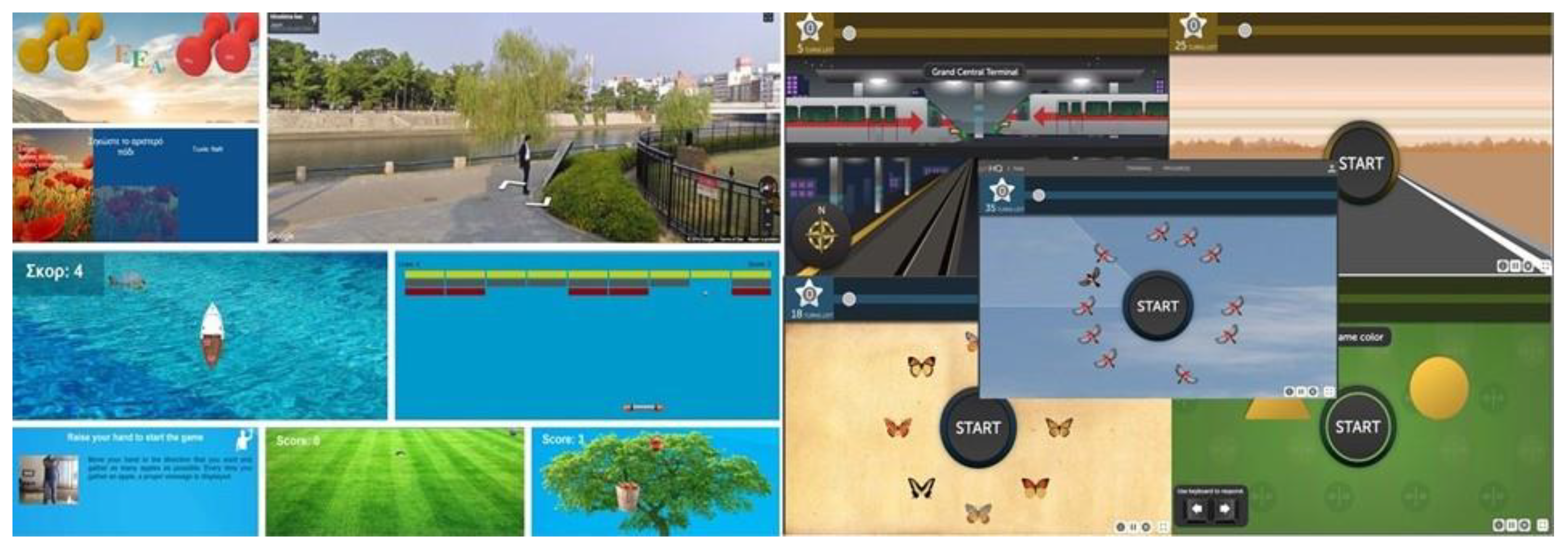

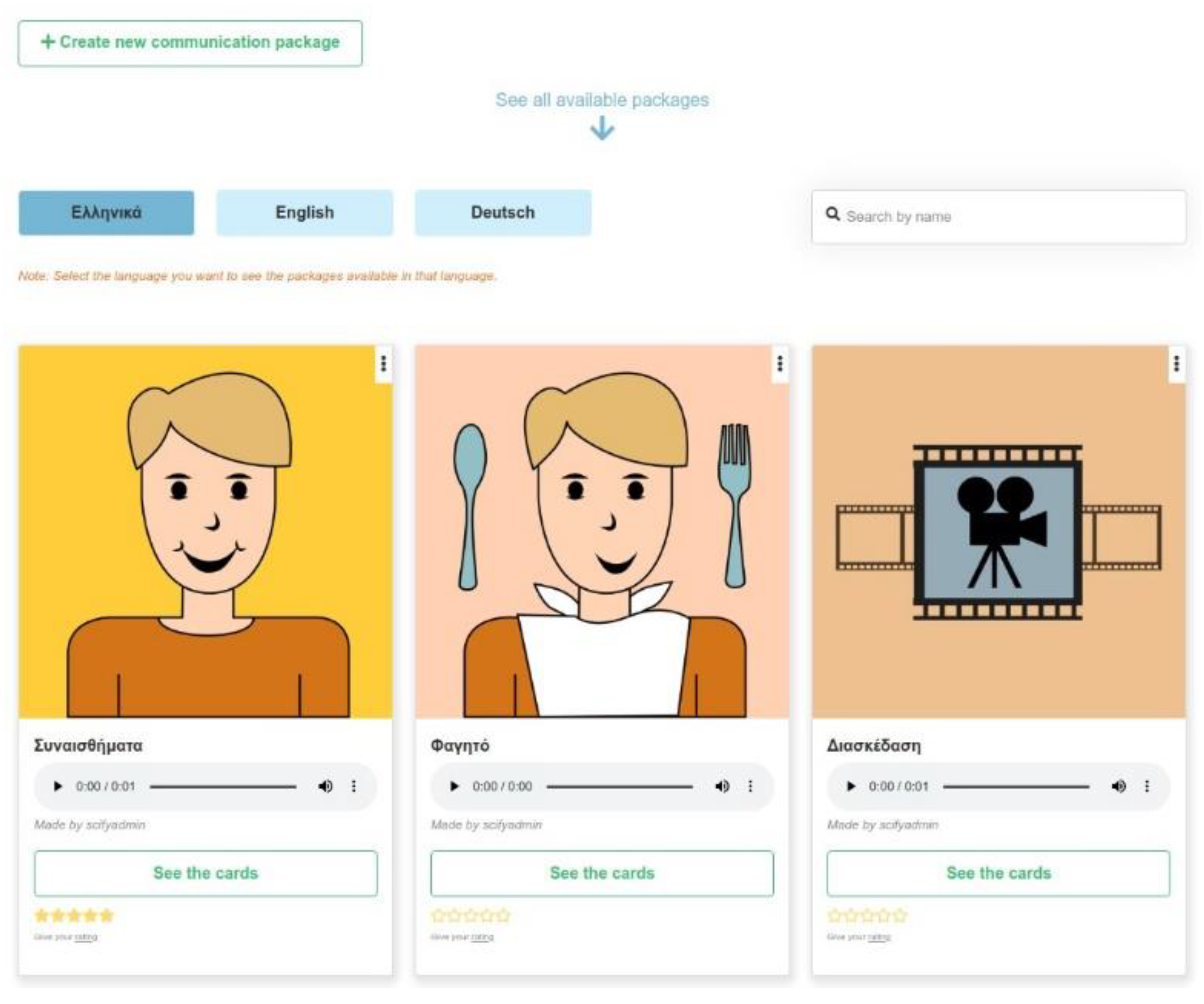

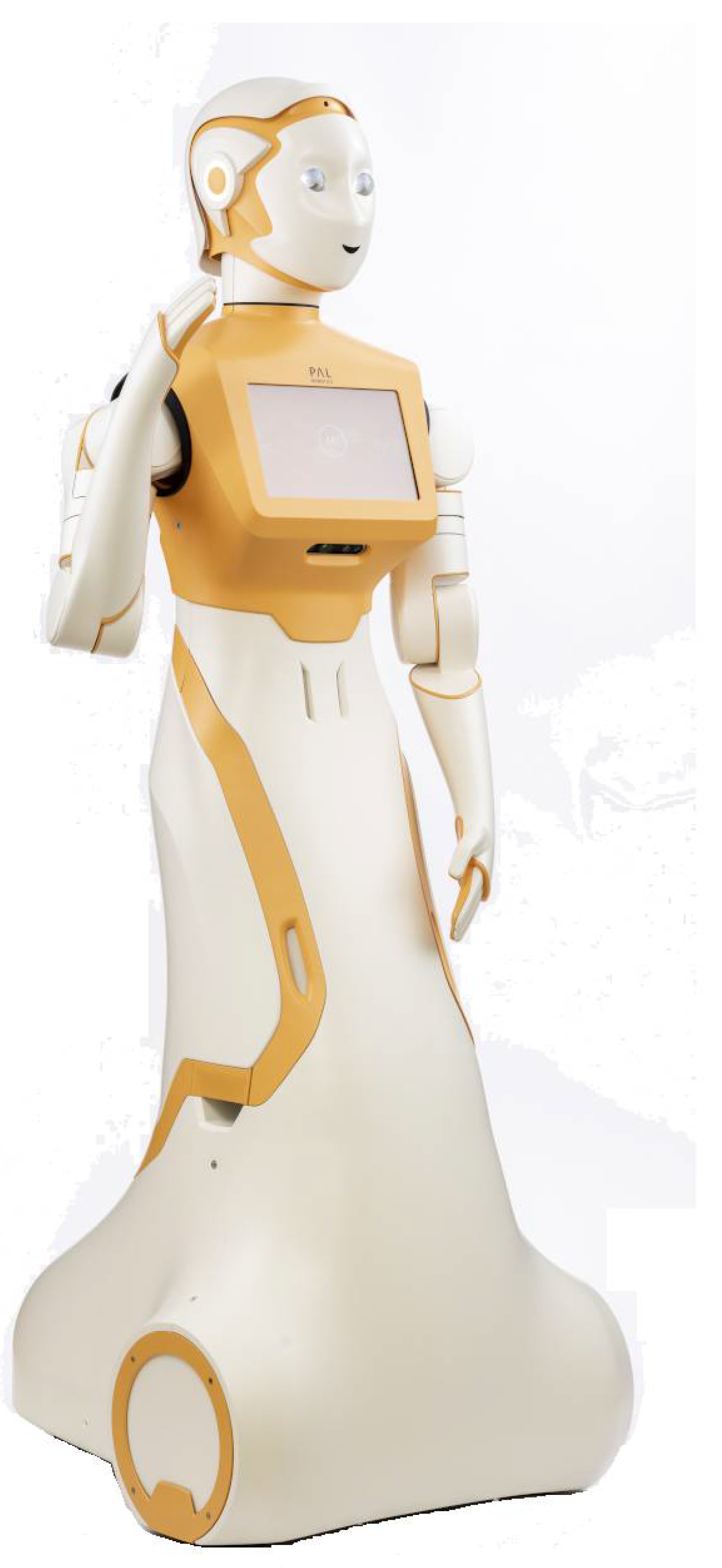
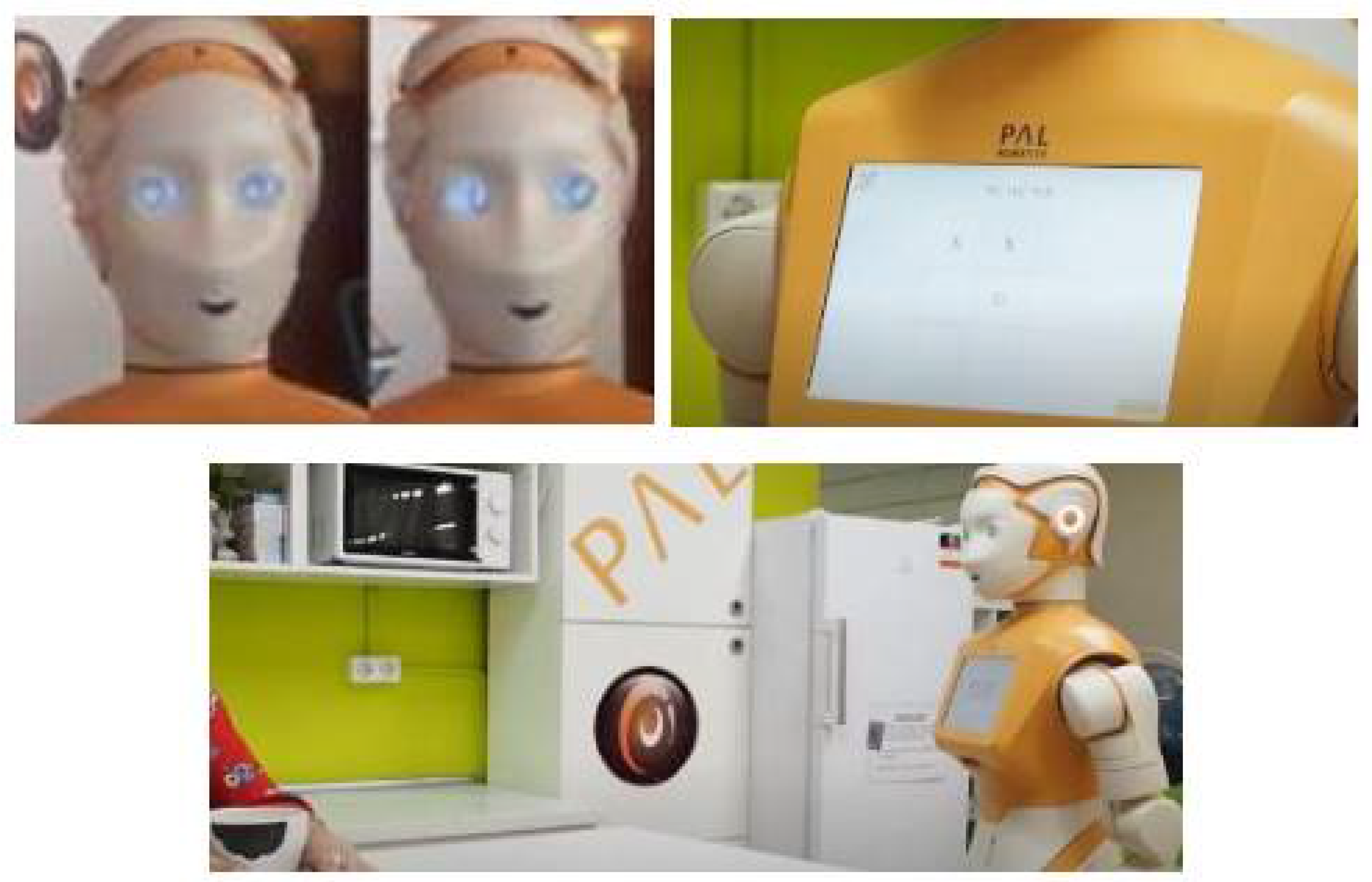
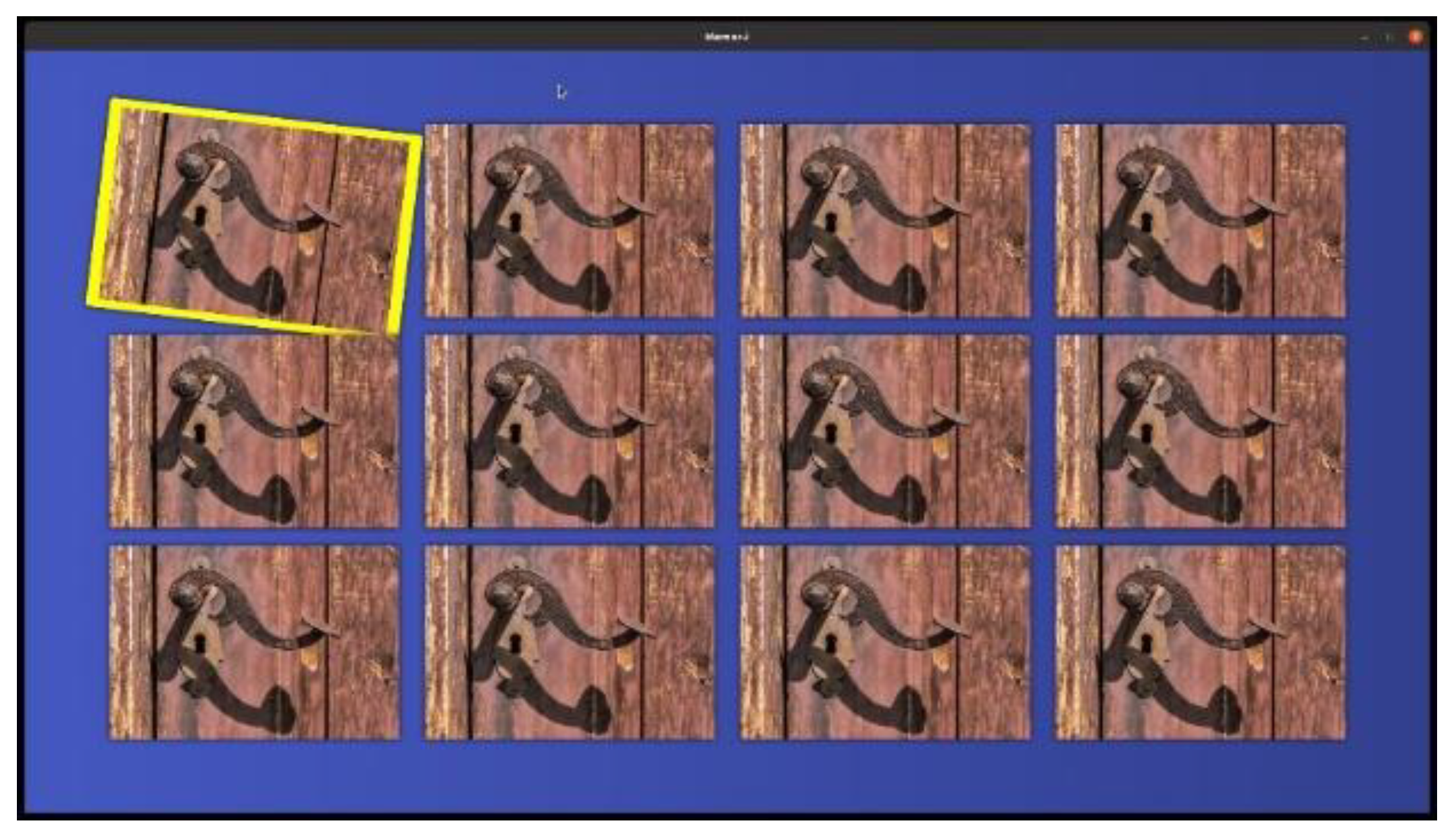
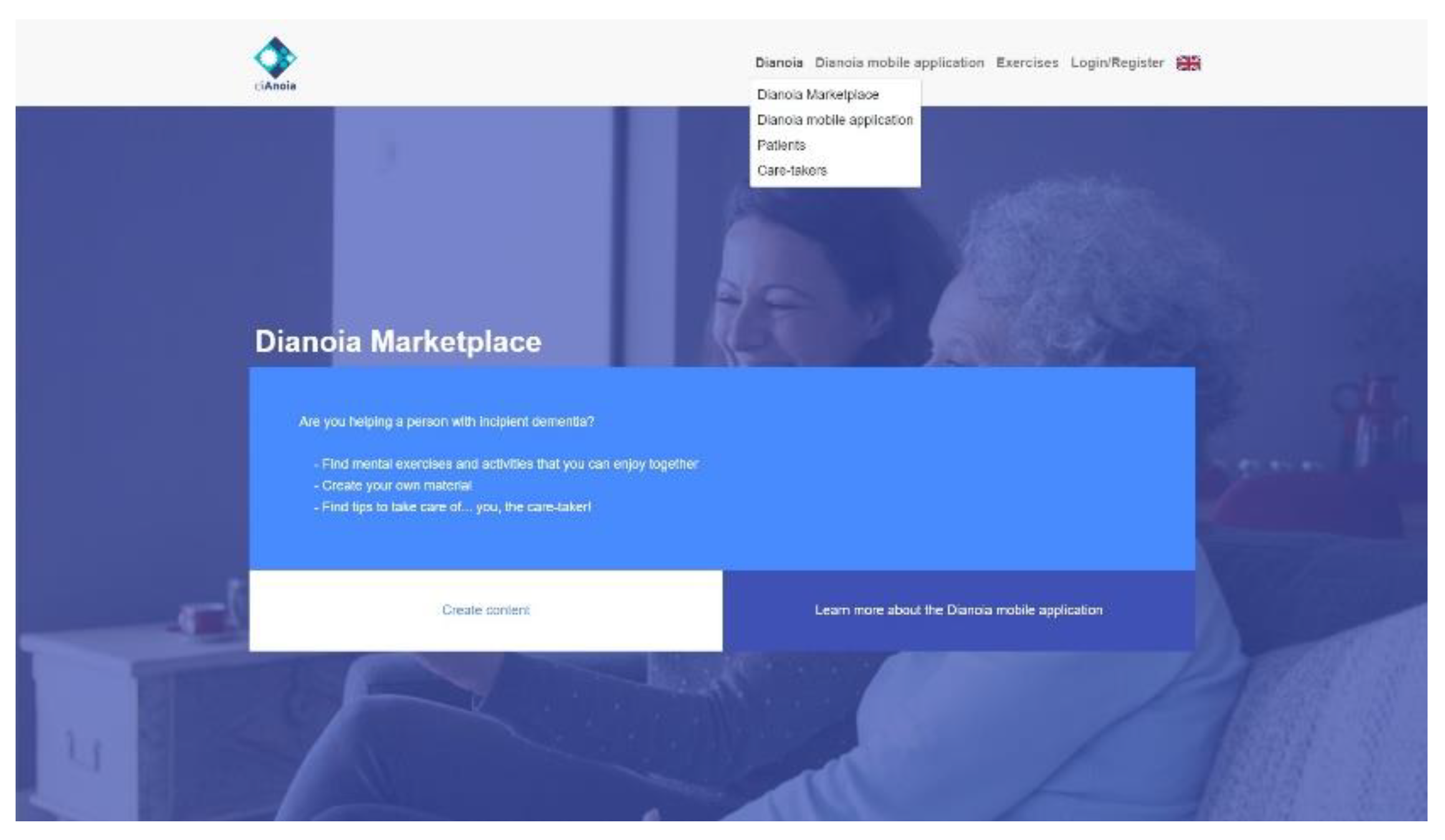

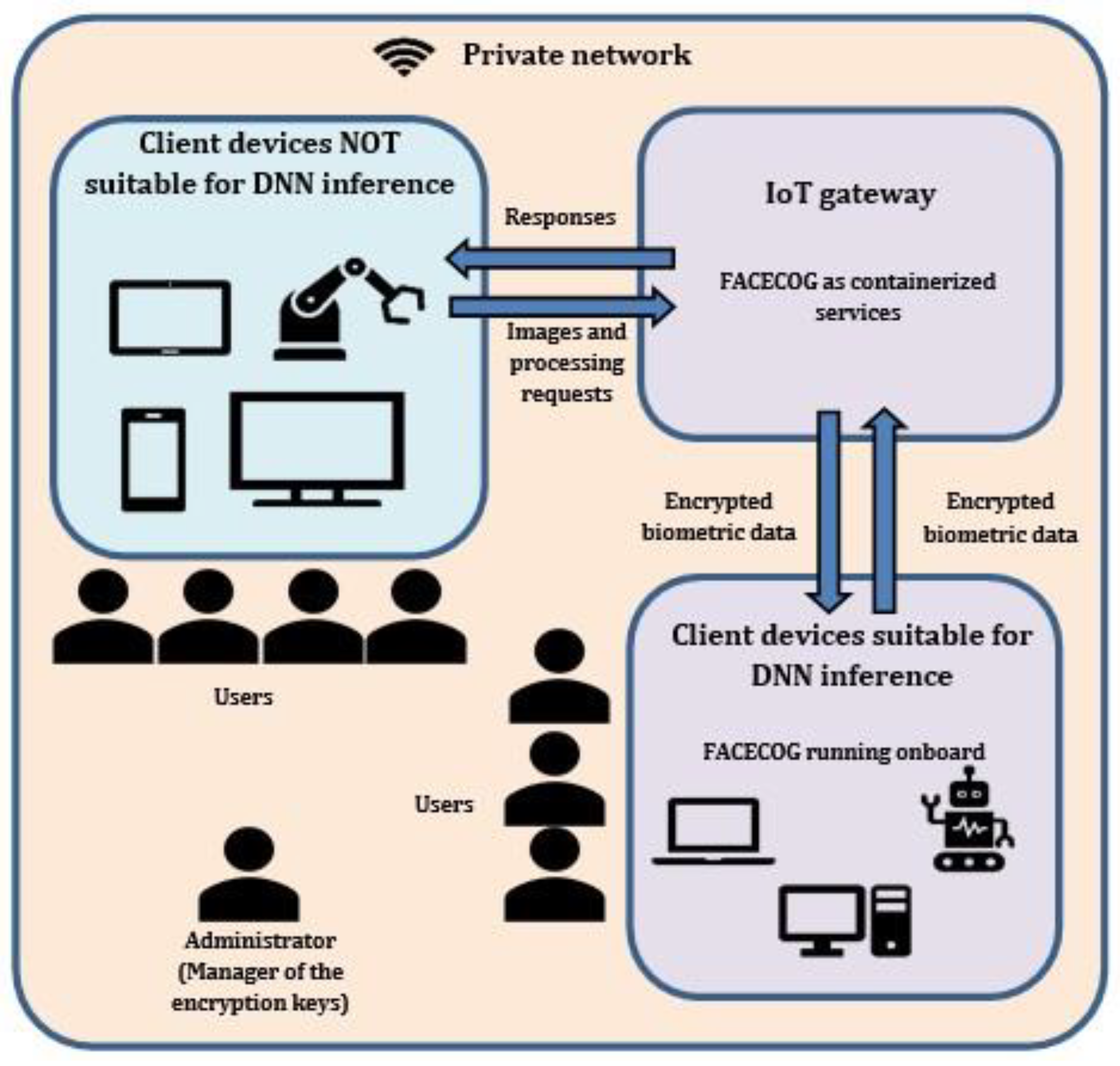

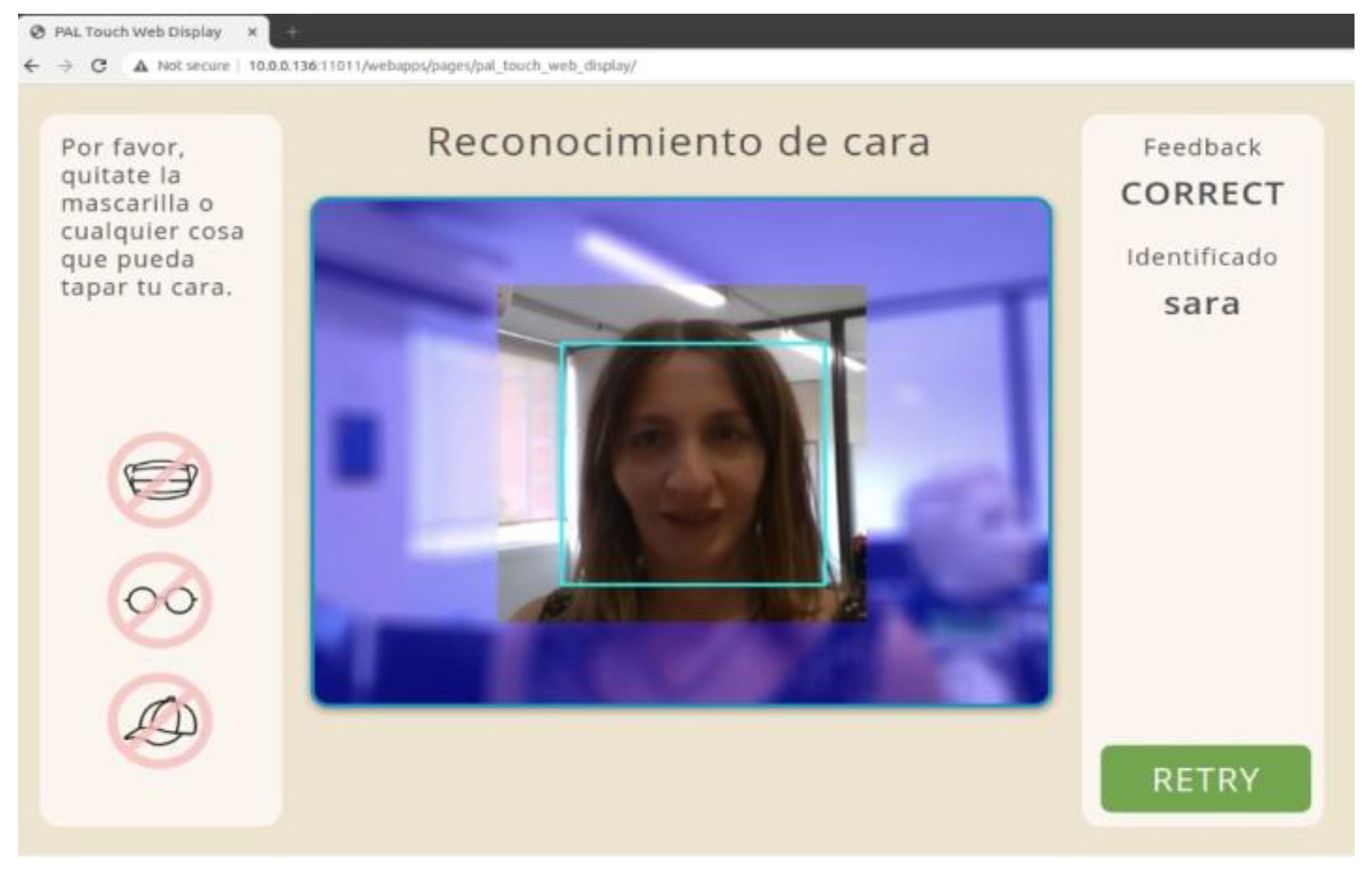

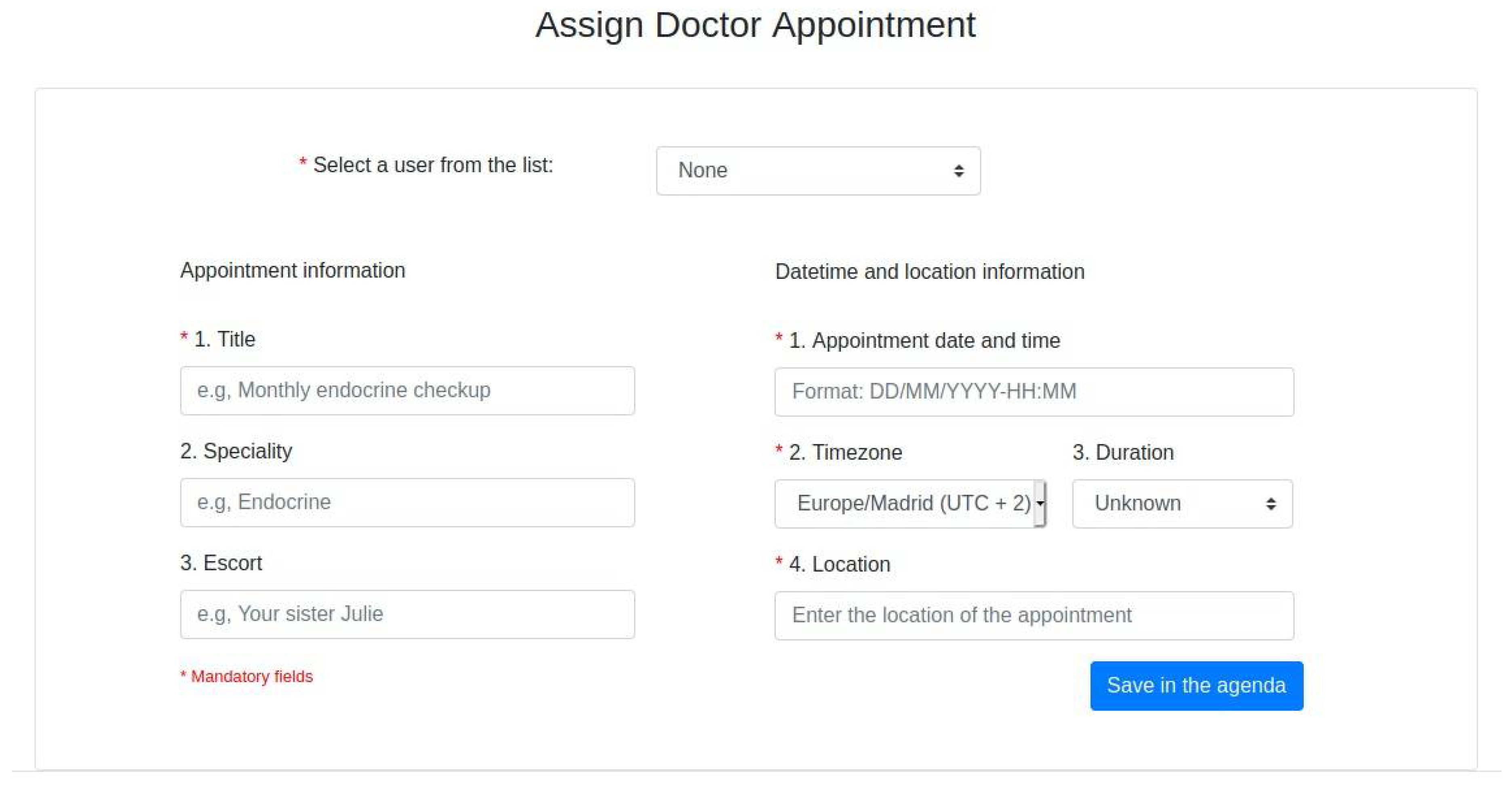
Publisher’s Note: MDPI stays neutral with regard to jurisdictional claims in published maps and institutional affiliations. |
© 2022 by the authors. Licensee MDPI, Basel, Switzerland. This article is an open access article distributed under the terms and conditions of the Creative Commons Attribution (CC BY) license (https://creativecommons.org/licenses/by/4.0/).
Share and Cite
Dratsiou, I.; Varella, A.; Romanopoulou, E.; Villacañas, O.; Cooper, S.; Isaris, P.; Serras, M.; Unzueta, L.; Silva, T.; Zurkuhlen, A.; et al. Assistive Technologies for Supporting the Wellbeing of Older Adults. Technologies 2022, 10, 8. https://doi.org/10.3390/technologies10010008
Dratsiou I, Varella A, Romanopoulou E, Villacañas O, Cooper S, Isaris P, Serras M, Unzueta L, Silva T, Zurkuhlen A, et al. Assistive Technologies for Supporting the Wellbeing of Older Adults. Technologies. 2022; 10(1):8. https://doi.org/10.3390/technologies10010008
Chicago/Turabian StyleDratsiou, Ioanna, Annita Varella, Evangelia Romanopoulou, Oscar Villacañas, Sara Cooper, Pavlos Isaris, Manex Serras, Luis Unzueta, Tatiana Silva, Alexia Zurkuhlen, and et al. 2022. "Assistive Technologies for Supporting the Wellbeing of Older Adults" Technologies 10, no. 1: 8. https://doi.org/10.3390/technologies10010008
APA StyleDratsiou, I., Varella, A., Romanopoulou, E., Villacañas, O., Cooper, S., Isaris, P., Serras, M., Unzueta, L., Silva, T., Zurkuhlen, A., MacLachlan, M., & Bamidis, P. D. (2022). Assistive Technologies for Supporting the Wellbeing of Older Adults. Technologies, 10(1), 8. https://doi.org/10.3390/technologies10010008










